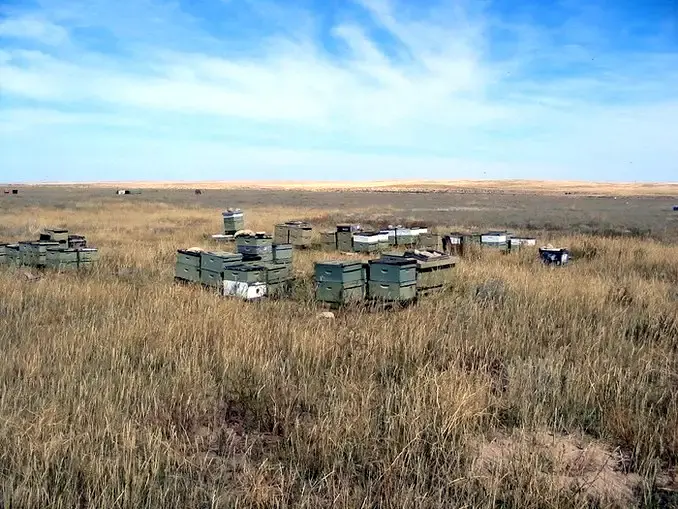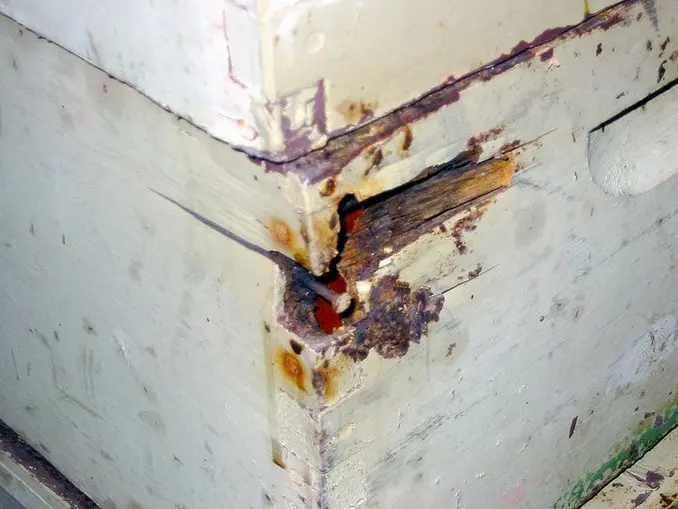Year 1 October - Wrapping Up the Journey 🖊️

-Living side by side with migratory commercial bees.
The small cell hives, tinted with a more olive hue, stand proudly in double deeps, while the large cell hives are arranged in a deep and a medium. Hidden behind the two pallets at the lower right, the top bar hive holds its own.
It’s been nine years since I dove into the small cell experiment, and I’ve got some updates to share.
In 2007, my relocation from Wyoming to Florida rendered it impractical to take those hives with me. In 2006, I began reconfiguring them as two-deep hives, aligning with the conventional setup in Florida. I ran them for a season, similar to my approach before learning the ropes of beekeeping. Details can be found at the bottom of the Checker Boarding page.
Come early spring in 2007, I handed over all my hives to a commercial beekeeper friend, with the promise to care for them and explore the effects of small cell comb.
Fast forward to 2008 when I returned to Wyoming, and in 2009, I reclaimed those hives. Despite being situated in a migratory commercial beeyard grappling with mites, foulbrood, and apis cerana, the small cell hives managed to survive without treatments.
Setting
After revamping a small cell test yard and operating it conventionally for a season, seven small cell hives found a new home with a migratory commercial beekeeper. He incorporated them to replace the dead outs scattered randomly on four-way pallets within a conventional, large cell, treated, commercial 12-pallet beeyard. Two top bar hives were tucked into the corner of the same yard.
- Pallets with small cell hives were overwintered in the beeyard.
- Remaining pallets were shipped to California for almond pollination.
- Additional pallets were shuffled in and out as needed.
- Small cell hives were left untreated.
- Small cell hives were managed identically to their treated large cell counterparts.
The small cell hives found themselves in a distinctive situation.
- Removed from advanced beekeeping techniques.
- Factors due to isolation and location were eliminated.
- Survival and production could be directly compared to treated, large cell hives.
Conditions
Their initial season in this yard witnessed the worst conditions.
- No hives produced any surplus.
- All entered winter light, with minimal pollen reserves.
The second season, though better than the first, still fell short.
- Bees produced less than an average crop.
- Most beeyards in the area stored only a few frames more honey than needed for survival.
The last two seasons proved to be among the worst in memory.
Status
Now back in Wyoming after my Florida stint, I’ve reclaimed those small cell hives. Here’s what I found after two seasons:
- All small cell hives thrived, except one with a queen failure.
- Another small cell hive was split to make up the difference.
- The top bar hive experienced a queen failure, expected given her age of over three years.
- Small cell hive honey production rivaled any in the yard.
- No visible mites, evidence of brood disease, or symptoms of PMS were detected in the small cell hives.
Contrast that with the surrounding large cell hives. Mites, showing apparent resistance to treatments, were evident. The commercial operation struggled with mites, necessitating treatments at every inspection. Symptoms of PMS were observed in a few hives. Most hives thrived with both bees and mites.
An outbreak of Terra-resistant foulbrood was rampant in the commercial operation, leading to Tylosin treatment for all large cell hives to contain the outbreak.
Most large cell hives faced queen supersedure problems, requiring requeening, and some more than once.
Indications
I’ve demonstrated that small cell yards can tolerate mites when surrounded by mite-infested large cell yards. However, doubts lingered about small cell hives thriving in the described conditions.
While dismantling this yard for migration and winter, initial observations suggest that small cell hives can handle mite loads when immersed in a commercial yard infested with mite-infected hives and run conventionally.
These small cell bees are flourishing and producing without treatment in a scenario where large cell hives demand almost continuous treatment to survive and perform the same.
A Closer Look
A week after dismantling the yard, I returned for a closer inspection of those small cell hives. Brood nests were opened and closely examined, searching for mite fecal deposits, disease, or anything unusual in the brood comb. Nothing unusual was found, and no phoretic mites were visible.
The failed top bar hive comb was also closely inspected. As expected, the queen had failed, but no fecal deposits were discovered in the top bar hive comb.
Results
Once enslaved by the scientific method, I might have opted for screened bottom boards and another round of mite counting. But that’s not my situation now. I’ve scrutinized these hives for several hours, and they’re thriving, even when surrounded by mite-infested, large cell hives and managed conventionally.
Parting Thoughts
The Bees

-Nine years have taken their toll on my small cell hives.
The initial impression of the small cell hives, upon returning to Wyoming, was the dilapidated state of the equipment. What was once new now exhibits signs of wear, with corners and covers succumbing to rot. Those once translucent combs in shades of yellow to white have turned opaque black. The paint is spotted, stained, bleached, peeling, and far from attractive.
While initially contemplating sending these hives to pollinate California almonds, I feared some equipment wouldn’t survive the journey and might create a mess for someone else to clean up.
To the casual observer, these hives may not hold much value. Yet, through them, I’ve gained valuable insights into bee behavior and embarked on an incredible adventure.
Me
My sentiments about small cell topics echo the condition of my small cell equipment—they’ve seen better days. I have a few loose ends, and that’s it. I might follow them or maybe not.
- I’ve penned down everything I want to about it.
- I’ve shared all my observations on the matter.
- I won’t be engaging in further discussions about it.
- It’s history.
Departure

-In this fading light, I find solace. A better place than fretting over mites.
It’s a splendid Indian summer day, with the resplendent fall colors of the mountains moments away. I’ve got better things to do than trying to ‘prove’ something to someone else or worrying about mites.
So, I’m bidding farewell to this beeyard. I’ll pick up my favorite woman, revel in some solitude, silence, and the beauty of distant heights. We’ll cruise down a single dirt track in my Jeep, find a warm, windless spot, and savor the last few moments before the snow settles in. Those small cell bees are doing just fine, even amid large cell, mite-infested hives, and in the care of a conventional beekeeper.
-Cheers, D 🐝🤠
